Historical Background
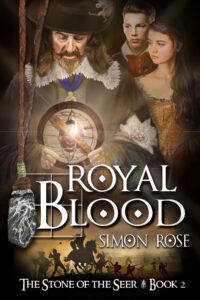 The story, main characters, and some of the settings in Royal Blood are fictional but are based on true events and the story features real historical characters, such as King Charles I. The English Civil War was a series of conflicts in England, Scotland, and Ireland in the 1640s and early 1650s. The war originated in the struggle between Charles I and Parliament regarding how the country should be governed.
The story, main characters, and some of the settings in Royal Blood are fictional but are based on true events and the story features real historical characters, such as King Charles I. The English Civil War was a series of conflicts in England, Scotland, and Ireland in the 1640s and early 1650s. The war originated in the struggle between Charles I and Parliament regarding how the country should be governed.
The king’s defeat in the civil war led to his trial and execution in January 1649. The monarchy was abolished and replaced first by the Commonwealth of England and then the Protectorate, before the monarchy was restored in 1660. However, the defeat of Charles I confirmed that an English monarch could not rule the country without the consent of Parliament, although this wasn’t legally established until the Glorious Revolution in 1688.
These are links to online sources where you can learn more about the historical events, settings, and leading characters from the English Civil War, some of the leading characters during the conflict, historical locations that are mentioned in the text, life in the seventeenth century, and details from other historical periods that are featured in the story.
Please note that all links to websites were fully operational at the time of the book’s publication.
The English Civil War
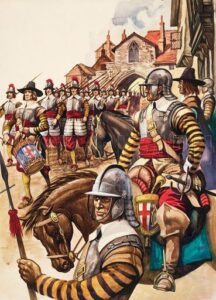 There is a great deal of material online about the English Civil War. These websites provide information on the background to the conflict, the political and religious ideas of the time, the opposing armies, and about the course of the war throughout the British Isles.
There is a great deal of material online about the English Civil War. These websites provide information on the background to the conflict, the political and religious ideas of the time, the opposing armies, and about the course of the war throughout the British Isles.
https://en.wikipedia.org/wiki/English_Civil_War
https://en.wikipedia.org/wiki/Roundhead
https://en.wikipedia.org/wiki/Cavalier
https://en.wikipedia.org/wiki/Timeline_of_the_English_Civil_War
https://kids.kiddle.co/English_Civil_War
https://www.history.com/topics/british-history/english-civil-wars
https://spartacus-educational.com/STUcivilwar.htm
http://bcw-project.org/church-and-state/first-civil-war/
http://bcw-project.org/timelines/the-english-civil-war
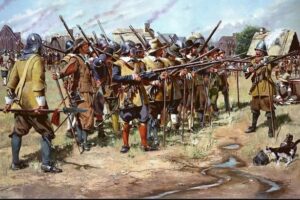
http://bcw-project.org/church-and-state/second-civil-war/
http://bcw-project.org/timelines/the-second-civil-war
This map shows the locations of some of the Civil War’s major battles.
https://olivercromwell.net/english-civil-war-battles/
These maps show territory held by the Royalists and that held by Parliament at different stages of the war.
Charles I (1600-1649)
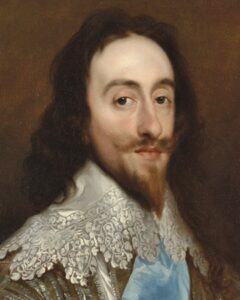 Charles I was King of England from 1625 to 1649. His disagreements with Parliament, which wanted to reduce his powers, led to the English Civil War. The king’s defeat resulted in his trial and execution in 1649.
Charles I was King of England from 1625 to 1649. His disagreements with Parliament, which wanted to reduce his powers, led to the English Civil War. The king’s defeat resulted in his trial and execution in 1649.
https://kids.kiddle.co/Charles_I_of_England
http://bcw-project.org/biography/charles-the-first
https://en.wikipedia.org/wiki/Charles_I_of_England
https://www.biography.com/royalty/charles-i
Oliver Cromwell (1599-1658)
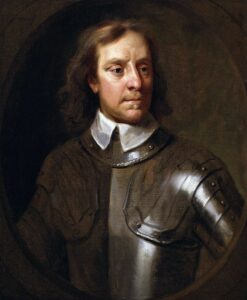 Oliver Cromwell was one of the main leaders of the Parliamentary forces in the civil war against Charles I. After the king’s execution, Cromwell ruled the country as the Lord Protector of the Commonwealth of England, Scotland, and Ireland.
Oliver Cromwell was one of the main leaders of the Parliamentary forces in the civil war against Charles I. After the king’s execution, Cromwell ruled the country as the Lord Protector of the Commonwealth of England, Scotland, and Ireland.
https://kids.kiddle.co/Oliver_Cromwell
http://bcw-project.org/biography/oliver-cromwell
https://en.wikipedia.org/wiki/Oliver_Cromwell
https://www.history.com/topics/british-history/oliver-cromwell
Henrietta Maria (1609-1669)
Henrietta Maria was the wife of Charles I and Queen of England from 1625 to 1649. As a Roman Catholic, she was unpopular in England and was forced to leave the country during the civil war. She returned to England after the Restoration in 1660, when her son became King Charles II.
https://en.wikipedia.org/wiki/Henrietta_Maria
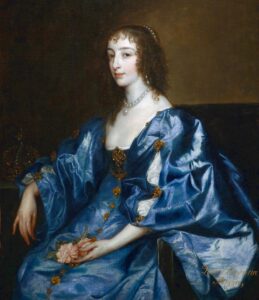
https://kids.kiddle.co/Henrietta_Maria_of_France
http://bcw-project.org/biography/henrietta-maria
Sir Thomas Fairfax (1612-1671)
Sir Thomas Fairfax was commander-in-chief of Parliament’s forces during the English Civil War.
https://en.wikipedia.org/wiki/Thomas_Fairfax
http://bcw-project.org/biography/sir-thomas-fairfax
Thomas Rainsborough (1610-1648)
Thomas Rainsborough was a Parliamentary officer and political activist during the civil war. He was closely associated with the Leveller movement.
https://en.wikipedia.org/wiki/Thomas_Rainsborough
http://bcw-project.org/biography/thomas-rainsborough
John Lilburne (1614-1657)
John Lilburne was a leading political activist and writer before, during, and after the English Civil War. He was closely associated with the Leveller movement.
https://en.wikipedia.org/wiki/John_Lilburne
https://spartacus-educational.com/STUlilburne.htm
http://bcw-project.org/biography/john-lilburne
Matthew Hopkins (1620-1647)
Matthew Hopkins was a witch-hunter during the English Civil War. He and his associates were responsible for sending more than a hundred people to their execution during the war.
https://en.wikipedia.org/wiki/Matthew_Hopkins
https://www.historic-uk.com/HistoryUK/HistoryofEngland/Matthew-Hopkins-WitchFinder-General/
Elizabeth Poole
Elizabeth Poole was a woman that claimed to be a prophet during the civil war. She was born in 1622 and last appears in the historical record in 1668.
https://www.jstor.org/stable/4052957?seq=1#page_scan_tab_contents
http://www.abingdon.gov.uk/history/people/elizabeth-poole
Pride’s Purge
Pride’s Purge took place on December 6, 1648, when soldiers prevented Members of Parliament that opposed the army from entering the House of Commons. This ensured that MPs would vote for the king’s trial, which led to his execution.
https://en.wikipedia.org/wiki/Pride%27s_Purge
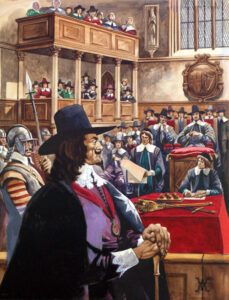
http://bcw-project.org/church-and-state/second-civil-war/prides-purge
The king’s trial and execution
There are many online sources for information regarding the trial and execution of Charles I in 1649.
https://en.wikipedia.org/wiki/High_Court_of_Justice_for_the_trial_of_Charles_I
http://bcw-project.org/church-and-state/the-commonwealth/trial-of-king-charles-i
http://www.prisonersofeternity.co.uk/the-trial-and-execution-of-charles-i-right-or-wrong/
https://history.hanover.edu/courses/excerpts/212trial.html
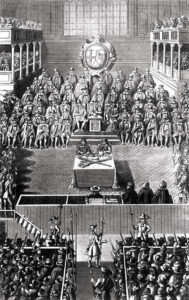
https://historylearning.com/stuart-england/charlesi-execution/
https://www.panmacmillan.com/blogs/history/the-final-hours-of-charles-i
https://en.wikipedia.org/wiki/Execution_of_Charles_I
https://www.historytoday.com/archive/execution-charles-i
http://www.eyewitnesstohistory.com/charlesI.htm
This image shows the High Court of Justice that was established for the trial of Charles I. The king is shown sitting alone in the dock, facing his accusers.
https://upload.wikimedia.org/wikipedia/commons/d/da/Court-charles-I-sm.jpg
This image shows the execution of Charles I in front of the Banqueting House on January 30, 1649.
https://upload.wikimedia.org/wikipedia/commons/9/9b/The_execution_of_King_Charles_I_from_NPG.jpg
Political activism
These websites have information about the political ideas and movements that were popular before and during the civil war.
https://en.wikipedia.org/wiki/Levellers
https://www.historic-uk.com/HistoryUK/HistoryofEngland/The-Levellers/
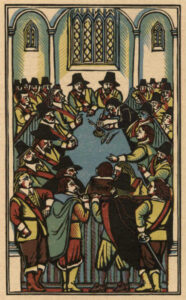
https://en.wikipedia.org/wiki/Diggers
https://spartacus-educational.com/STUdiggers.htm
The Putney Debates
The Putney Debates were a series of discussions about creating a new constitution for the country at the end of the English Civil War.
https://spartacus-educational.com/STUputneydebates.htm
https://en.wikipedia.org/wiki/Putney_Debates
http://bcw-project.org/church-and-state/second-civil-war/putney-debates
Seventeenth century England
This website provides information on what it was like to live in England in the seventeenth century.
http://www.localhistories.org/stuart.html
Religion in the seventeenth century
These websites have information about the religious situation in England at the time of the civil war. This includes details on secret Catholic places of worship, similar to the underground workshop located at Habingdon House.
https://www.historic-uk.com/HistoryUK/HistoryofEngland/Priests-Holes/
https://www.atlasobscura.com/articles/the-secret-rooms-that-were-custom-built-to-hide-your-priest
https://www.nationaltrust.org.uk/lists/priest-holes
Habingdon, Essex, and London
The fictional Habingdon House and the nearby village are located in the county of Essex in Southeast England. This map of England’s counties shows the location of Essex in relation to London.
http://myenglandtravel.com/images/all_england_counties_map.gif
Seventeenth century London
These two websites provide information on what it was like to live in London in the seventeenth century.
https://en.wikipedia.org/wiki/Stuart_London
http://www.localhistories.org/london17thcent.html
This map of London in 1660 is similar to how the city would have looked at the time of the civil war.
http://www.antique-maps-online.co.uk/london-rutger-2992.jpg
Virtual tour
This link features a video depicting what the city of London would have looked like in the years around the time of the English Civil War.
http://www.openculture.com/2013/11/fly-through-17th-century-london.html
Old London Bridge
Old London Bridge was first built in the medieval period and had multiple arches. A great many buildings were also built on the bridge over the years. The bridge was the only crossing over the Thames in the London area until Westminster Bridge was built in 1750. Old London Bridge was demolished in 1831.
https://en.wikipedia.org/wiki/London_Bridge#%22Old%22_London_Bridge_(1209%E2%80%931831)
https://thetudortravelguide.com/2019/03/02/old-london-bridge/
https://www.thehistoryoflondon.co.uk/the-medieval-london-bridge/
This image shows London Bridge and parts of the city, as it would have appeared in 1616 and during the civil war.
https://i1.wp.com/www.earlymodernengland.com/wp-content/uploads/2016/11/z19london.jpg?ssl=1
Medieval monasteries
These links have excellent information on medieval monasteries and the scriptoriums where illuminated manuscripts were created.
https://en.wikipedia.org/wiki/Scriptorium
https://www.historytoday.com/secrets-scriptoria
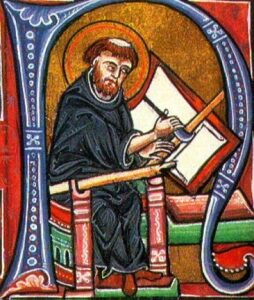
https://en.wikipedia.org/wiki/Monastery
https://www.ancient.eu/Medieval_Monastery/
https://en.wikipedia.org/wiki/Illuminated_manuscript
https://www.ancient.eu/Illuminated_Manuscripts/
https://www.ancient.eu/Book_of_Kells/
https://www.ancient.eu/article/1293/the-daily-life-of-medieval-monks/
https://en.wikipedia.org/wiki/Monk
https://www.ancient.eu/Medieval_Church/
The Vikings
The Vikings were people from Scandinavia in Northern Europe and the Viking Age was from around 700 to 1000 AD. During that time, the Vikings attacked countries on the coasts of Europe and often raided the British Isles, where the Vikings also settled and founded their own kingdoms.
https://en.wikipedia.org/wiki/Vikings
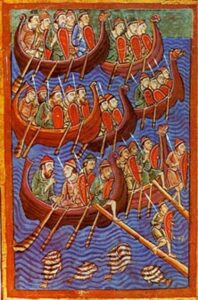
https://www.history.com/topics/exploration/vikings-history
https://www.ancient.eu/Vikings/
https://en.wikipedia.org/wiki/Great_Heathen_Army
https://www.historic-uk.com/HistoryUK/HistoryofEngland/Great-Heathen-Army/
https://kids.kiddle.co/Great_Heathen_Army
This map shows the path of the Great Heathen Army of Vikings that attacked England in 865.
https://en.wikipedia.org/wiki/Great_Heathen_Army#/media/File:England_Great_Army_map.svg
This map shows the areas controlled by the Vikings and Anglo-Saxons in the British Isles in 886.
Leonardo da Vinci (1452-1519)
Leonardo da Vinci was a painter, architect, and inventor during the Renaissance in the late fifteen and early sixteenth centuries. He is known for his famous paintings but also worked on a number of inventions, including flying machines, and studied the workings of the human body.
https://en.wikipedia.org/wiki/Leonardo_da_Vinci
https://www.history.com/topics/renaissance/leonardo-da-vinci
https://www.leonardodavinci.net/
The Tower of London
The Tower of London is a historic castle first founded after the Norman Conquest of England in 1066. It houses the British crown jewels and has held many famous prisoners over the centuries.
https://en.wikipedia.org/wiki/Tower_of_London
https://www.livescience.com/42821-tower-of-london.html
The Palace of Whitehall
The Palace of Whitehall in London was the main home of the English monarchs, including Charles I, from 1530 until 1698, when the palace was destroyed by fire.
https://en.wikipedia.org/wiki/Palace_of_Whitehall
http://www.everycastle.com/Whitehall-Palace.html
https://kids.kiddle.co/Palace_of_Whitehall
The Banqueting House
The Banqueting House was the only part of the Palace of Whitehall that survived the fire of 1698. Charles I was executed in front of the Banqueting House in January 1649.
https://en.wikipedia.org/wiki/Banqueting_House,_Whitehall
https://www.hrp.org.uk/banqueting-house/history-and-stories/the-story-of-banqueting-house/
https://www.britainexpress.com/London/Banqueting_House.htm
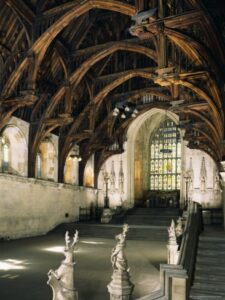 Westminster Hall
Westminster Hall
Westminster Hall in London is the oldest part of the Palace of Westminster. The hall was built in 1097 and has been used for a variety or purposes over the centuries, including the trial of Charles I in 1649.
https://en.wikipedia.org/wiki/Palace_of_Westminster#Westminster_Hall
https://www.parliament.uk/about/living-heritage/building/palace/westminsterhall/
https://lostcityoflondon.co.uk/tag/westminster-hall/
St. James’s Palace
St. James’s Palace is a royal residence in London, built in the 1530s. Charles I spent his final night at St James’s before his execution.
https://en.wikipedia.org/wiki/St_James%27s_Palace
https://kids.kiddle.co/St_James%27s_Palace
https://www.royal.uk/royal-residences-st-jamess-palace
The Protectorate
The Protectorate lasted from 1653 to 1659, when a Lord Protector ruled the Commonwealth of England, Scotland, and Ireland.
https://en.wikipedia.org/wiki/The_Protectorate
https://kids.kiddle.co/The_Protectorate
http://bcw-project.org/church-and-state/the-protectorate/
The Commonwealth
The Commonwealth refers to the time after the execution of Charles I in 1649 when England and Wales, and later Scotland and Ireland, were ruled as a republic.
https://en.wikipedia.org/wiki/Commonwealth_of_England
https://kids.kiddle.co/Commonwealth_of_England
https://spartacus-educational.com/STUcommonwealth.htm
http://bcw-project.org/church-and-state/the-commonwealth/
The Restoration
The Restoration occurred when Charles II returned from exile to become King of England in 1660.
https://en.wikipedia.org/wiki/The_Restoration
https://www.history.com/this-day-in-history/the-english-restoration
http://bcw-project.org/church-and-state/the-restoration/
Charles II (1630-1685)
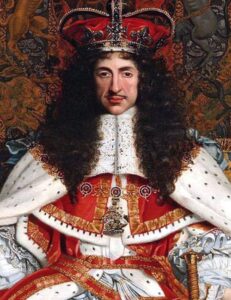 Charles was the eldest son of Charles I and Henrietta Maria. He was only a teenager during the civil war but still took part in some of the campaigns. Charles went into exile in 1646, first in France and then in the Netherlands. He returned to England as king following the Restoration in 1660.
Charles was the eldest son of Charles I and Henrietta Maria. He was only a teenager during the civil war but still took part in some of the campaigns. Charles went into exile in 1646, first in France and then in the Netherlands. He returned to England as king following the Restoration in 1660.
https://en.wikipedia.org/wiki/Charles_II_of_England



